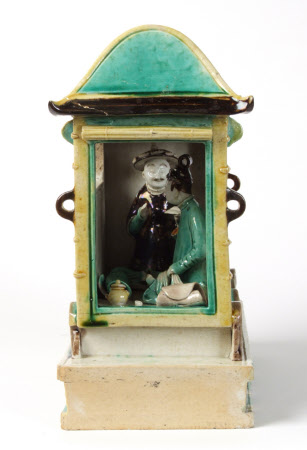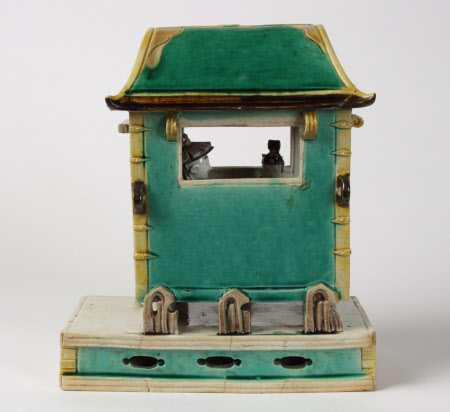Figural group
Category
Ceramics
Date
1662 - 1722
Materials
Porcelain, enamel, lead glaze.
Measurements
20.5 cm (H), 17.8 cm (W), 10.4 cm (D)
Place of origin
Jingdezhen
Order this imageCollection
Polesden Lacey, Surrey
NT 1245682
Summary
Porcelain figure group, Chinese, Kangxi period (1662–1722). Representing a rectangular palanquin with a domed roof, a female and a male passenger inside, on a rectangular base, decorated with green, yellow and brown enamels on the biscuit (or unglazed surface) and with a transparent lead glaze on details like faces and hands, originally part of a larger group, probably made in Jingdezhen, Jiangxi province, China.
Full description
The palanquin, a form of transport designed to be carried by human bearers, was regularly used by upper-class Chinese. This model must originally have had shutters, poles and bearers. The sancai or ‘three colours’ glaze palette, used on earthenware during the Tang dynasty (618–907), was revived for use on porcelain during the Kangxi reign, c. 1700, as an antiquarian style. A pair of very similar models of palanquins, formerly in the collection of the Hon. Nellie Ionides (nos. 309 and 310), were sold at auction at Christie's, London, 17 June 2003, lot 151 (no. 310 was subsequently sold at auction at Christie's, New York, 29 March 2006, lot 487). See also NT 1245681, an associated figural group representing a man with a packhorse. (Emile de Bruijn, April 2020)
Provenance
Bequeathed to the National Trust by Dame Margaret Greville, DBE (1863-1942).


